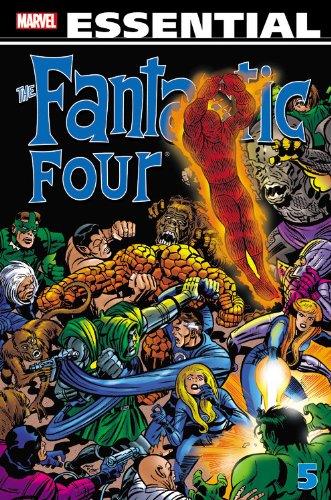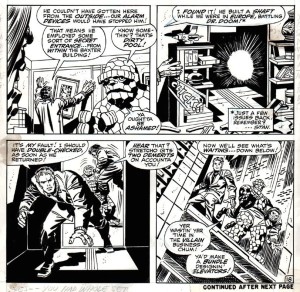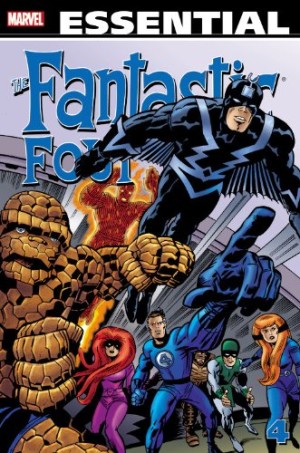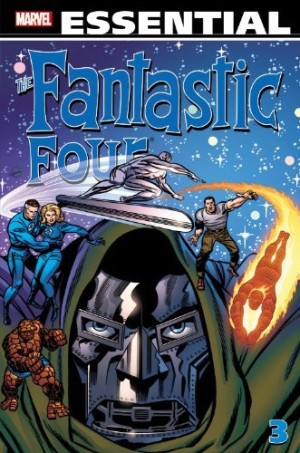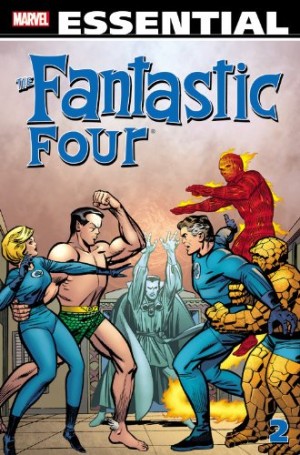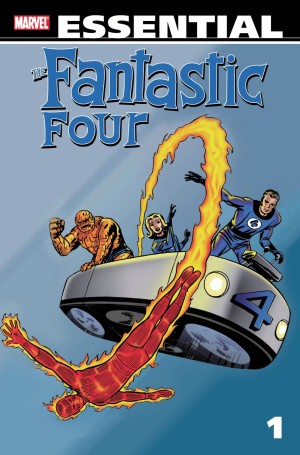Review by Graham Johnstone
Jack Kirby’s phenomenal ten-year run on the Fantastic Four with Stan Lee is concluded in this fifth black and white phonebook edition.
Kirby by this time was apparently unhappy at Marvel, feeling he was insufficiently recognised or rewarded for his work. His disenchantment shows. Take the titles for a start: ‘Within This Tortured Land!’, ‘Victims!’, ‘The Thing Enslaved’. You can read it into the story-lines too. The Inhumans story is about a ‘mad’ dictator, and the Dr Doom story about a calculating dictator. In the Mole Man story the very house the Fantastic Four live in is a trap intended to destroy them. They’ve been hypnotised to lose their powers, and now they’re blinded.
While most of the FF’s earthly foes seem gentlemen in a game of cricket, Dr Doom is a convincing psychopath. Psychologists now see trauma as a key component of what makes a psychopath, and that’s there in the disfiguring accident that trapped him in a metal suit and mask. He rules fictional central European kingdom Latveria, with a (literal and figurative) iron hand, ensuring smiling displays of devotion with the very real threat of execution. He’s also Machiavellian, endlessly contriving and manipulating situations like the escape of rebels in a conveniently placed tank, only to show his new weapons destroying it. For the FF, he plans to hypnotically instil a disabling fear of their own powers, trapping them forever as living monuments to his power and victory. It’s reminiscent of the nightmarish novels of Franz Kafka, possibly via The Prisoner TV show for which Kirby would later draw pages for an abortive Marvel series.
Kirby had been plotting the stories for years, and created supporting characters that remain lucrative properties today: the Silver Surfer, the Black Panther, and the Inhumans. By this time he was already in contract negotiations with rivals DC, explaining the relative lack of new ideas here, and dependence on returning characters. There are reappearances from the archly alliterative Frightful Four, Soviet rival the Red Ghost, master-planner the Mad Thinker, the Mole Man, the Sub-Mariner, and the alien Skrulls. Some stories, like the Dr Doom sequence are among the best of the series, but by the end of this volume it feels like we’re watching reruns.
New characters include the Monocle, organised crime gangsters the Maggia, and the unnamed, unspeaking “Monster of the Lost Lagoon” – none of them likely to top a vote for a reappearance. The Richards’ nanny (and secretly witch) Agatha Harkness, with her American Gothic house, and transforming cat familiar, is a nice addition, but not one Marvel have yet been able to monetise!
Stories also run longer, with everything here running over two, three or four twenty page episodes. You could read this as Kirby padding the material, but the reduction in narrative content per episode is offset by the greater visual immersion.
There’s no sign anywhere here of Kirby slacking on the artwork – he probably couldn’t have done it if he tried. These pages are as dynamic and brilliantly composed as ever. The Inhumans in particular, are all visually different and dazzling, and Kirby seems to revel in these scenes, especially Medusa’s living, writhing, panel filling hair. Incongruously some of the other best images (and many of the splash pages) are domestic ones – especially the Thing up dancing in a suit!
On the last two stories, John Romita (Senior) takes over. He’s a capable and dynamic artist, but to connoisseurs, no match for Kirby. These stories also appear in the colour Marvel Masterworks volumes 9 and 10, and split between Fantastic Four Omnibus volumes 3 and 4.
